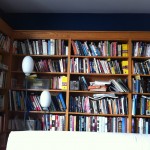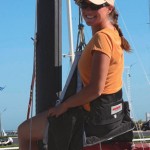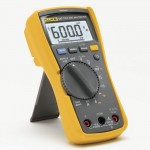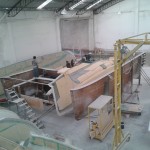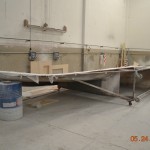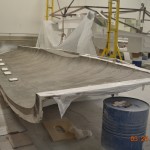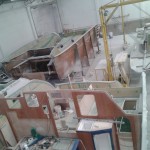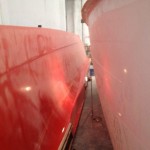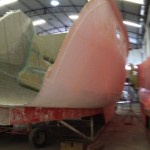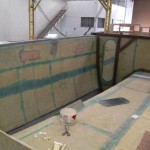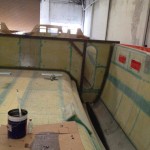We have recently spent a lot of time buying tools, learning about engines and other non-sailing boat activities so I thought it might be good for me to learn how to sail. Not that I haven’t sailed before. Jason and I raced Vanguard-15s for a few years and we did take a course in BVI (click here to see the post), but I still need to develop a better feel for the water and work on my ability to execute actions quickly.
I decided to enroll in Manhattan Yacht Club’s (MYC) Basic Coastal Cruising Class (aka ASA 103). MYC is a hidden treasure. They have a fleet of J-24s and a J-105 docked right at the World Financial Center. Jason has belonged there for over 20 years but because he was mostly racing J-24s, I never accompanied him. I decided not to start at the very beginning level – Basic Keelboat – but to go out twice on my own with an instructor and then go to the class.
My first sail was 2 hours with instructor Andrew. When I got to the dock, the boat was fully rigged (yeah!), except for the Jib because he wanted to see me tie a bowline. Fortunately, I had practiced that the day before. For anyone looking to refresh boat knot skills, I highly recommend Grog’s Animated Knots app. My big accomplishment was steering the whole time we were out. We had some great weather – wind 10 to 15 knots – and I learned first hand about weather helm. Andrew’s calm demeanor was great and he interjected with some very useful tips from time to time. Good news again when we got ashore – they were using the boat again and no de-rigging. Did I mention that when we sailed Vanguard-15s I was a bit of a Prima Donna? When we got back to the sailing club, I always got to shower while Jason de-rigged the boat. That may change soon.
The next week, I went sailing with Andrew again and told him I had two goals: 1) Control both the tiller and the main sheet, and 2) not get seasick. So I made sure to take Bonine and drink lots of water and he helped me get more comfortable at the helm. Progress!
So now for the big event. I was slightly trepidatious about two full days of sailing. Ever since a few bad seasick experiences last year, I get slightly nervous about going out. I took my medication and drank a lot of water and I was fine for both days. The sailing couldn’t have been better. Our instructor, Javier, was also great. He was calm, knowledgeable and very thoughtful. We rotated being at the helm, so I had to forget about being timid very quickly. On our first day we sailed to the Verazzano Narrows Bridge and back. Lots of traffic in the harbor made it challenging, but with many lookouts and voices on the boat, we were safe. We all had our own points of view – mine was that we were in a cruising course and really shouldn’t need to tack and gybe so much. Others were focused on finding refreshments or going for a swim (Yes, in the Hudson. Not for me.) Needless to say, Javier didn’t really agree. We tried to convince Javier to take a break at Red Hook – some of the crew were focused on some afternoon caffeine but our request was vetoed. We also practiced man overboard, or lifejacket overboard and docking. Everyone had to take their turn steering through both skills and we all made it.
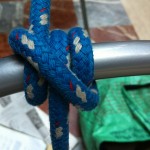
Rolling Hitch Knot
Day two the wind was light (1 knot gusting to 2 knots) in the morning so we stayed on land and took our exam and practiced our knot-tying. Javier was a good teacher because I finally can remember how to tie a rolling hitch! We also all passed our tests! All of those pop-quizzes Jason has been giving me have finally paid off.
We headed up to the George Washington Bridge very slowly because the wind was still light, reaching back and forth across the Hudson River. As you go North, there are fewer boats, so that part was a bit more relaxing. Eventually we anchored and took a break at the Inwood Marina. We were again turned down when we asked to let one of the crew swim ashore and fetch some refreshments. Maybe when we come through with Two Fish the Marina part will be open. I had fun using the Navionics iPhone app to check our depth, report on the windspeed at Robbins Reef, and record some of our track. By 4pm, the wind had shifted and picked up during our return, so it was a fun sail back and we were all ready for some drinks at The Mermaid, MYC’s marina barge.
It was fantastic for me to be sailing and to gain a few more skills and increase my confidence. Mostly, it was great to have a fun time on the water and remember what all of the current planning is working towards. I hope to go out with the MYC boats a few more times this summer and keep learning. –Gail
-
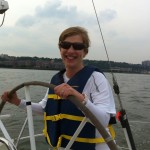
-
Helming a J105
-

-
Eager to Sail
-
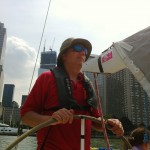
-
Javier of MYC at the Helm
-
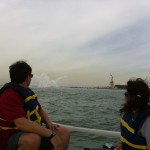
-
Sailing past the Statue of Liberty
-
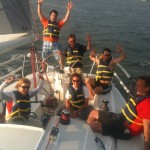
-
A great day for all
-
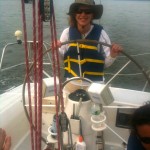
-
Gail at Helm
-

-
Helping the boat heel, or, cooling our feet?
-

-
Rolling Hitch Knot
-

-
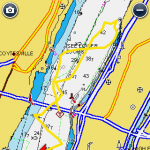
-
Navionics iPhone app
